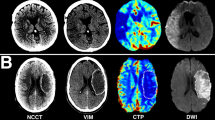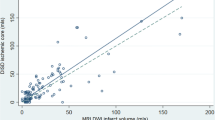Abstract
Purpose
Evaluation of water material density images (wMDIm) of dual-energy CT (DECT) for earlier prediction of final infarct volume (fiV) in follow-up single-energy CT (SECT) and correlation with clinical outcome.
Methods
Fifty patients (69 years, ± 12.1, 40–90, 50% female) with middle cerebral artery (MCA) occlusions were included. Early infarct volumes were analyzed in monoenergetic images (MonoIm) and wMDIm at 60 keV and compared with the fiV in SECT 4.9 days (± 4) after thrombectomy. Association between infarct volume and functional outcome was tested by linear regression analysis.
Results
wMDIm shows a prior visible infarct demarcation (60.7 ml, ± 74.9 ml) compared with the MonoIm (37.57 ml, ± 76.7 ml). Linear regression analysis, Bland–Altman plots and Pearson correlation coefficients show a close correlation of infarct volume in wMDIm to the fiV in SECT (r = 0.86; 95% CI 0.76–0.92), compared with MonoIm and SECT (r = 0.81; 95% CI 0.69–0.89). The agreement with SECT is substantially higher in patients with infarct volumes < 70 ml (n = 33; 66%). Coefficients were smaller with r = 0.59 (95% CI 0.31; 0.78) for MonoIm and SECT compared with r = 0.77 (95% CI 0.57; 0.88) for wMDIm and SECT. At admission, the mean NIHSS score and mRS were 17.02 (± 4.7) and 4.9 (± 0.2). mRS ≤ 2 was achieved in 56% at 90 days with a mean mRS of 2.5 (± 0.8) at discharge.
Conclusion
Material decomposition allows earlier visibility of the final infarct volume. This promises an earlier evaluation of the dimension and severity of infarction and may lead to faster initiation of secondary stroke prophylaxis.





Similar content being viewed by others
Abbreviations
- wMDIm:
-
Water material density images
- MonoIm:
-
Monoenergetic images
- DECT:
-
Dual-energy CT
- fiV:
-
Final infarct volume
- MCA:
-
Middle cerebral artery
- SECT:
-
Single-energy CT
- IodMDIm:
-
Iodine material density image
- NIHSS:
-
National Institutes of Health Stroke Scale
- mRS:
-
Modified Rankin Scale
- ECASS:
-
European Cooperative Acute Stroke Study
- mTICI:
-
Modified treatment in cerebral infarction score
- AsiR:
-
Adaptive statistical iterative reconstruction
- ASPECTS:
-
Alberta stroke program early CT score
References
del Zoppo GJ, von Kummer R, Hamann GF (1998) Ischaemic damage of brain microvessels: inherent risks for thrombolytic treatment in stroke. J Neurol Neurosurg Psychiatry 65(1):1–9 Review
Mohammed MF, Marais O, Min A et al (2018) Unenhanced dual- energy computed tomography: visualization of brain edema. Investig Radiol 53:63–69
Postma AA, Das M, Stadler AA, Wildberger JE (2015) Dual-energy CT: what the neuroradiologist should know. Curr Radiol Rep 3(5):16 Review
Johnson TR (2012) Dual-energy CT: general principles. AJR Am J Roentgenol 1(99):S3–S8
McCollough CH, Leng S, Yu L et al (2015) Dual-and multi-energy CT: principles, technical approaches, and clinical applications. Radiology. 276:637–653
Goo HW, Goo JM (2017) Dual-energy CT: new horizon in medical imaging. Korean J Radiol 18(4):555–569
Phan CM, Yoo AJ, Hirsch JA, Nogueira RG, Gupta R (2012) Differentiation of hemorrhage from iodinated contrast in different intracranial compartments using dual-energy head CT. AJNR Am J Neuroradiol 33(6):1088–1094
Gupta R, Phan CM, Leidecker C, Brady TJ, Hirsch JA, Nogueira RG, Yoo AJ (2010) Evaluation of dual-energy CT for differentiating intracerebral hemorrhage from iodinated contrast material staining. Radiology 257(1):205–211
Tijssen MP, Hofman PA, Stadler AA, van Zwam W, de Graaf R, van Oostenbrugge RJ, Klotz E, Wildberger JE, Postma AA (2014) The role of dual energy CT in differentiating between brain haemorrhage and contrast medium after mechanical revascularisation in acute ischaemic stroke. Eur Radiol 24(4):834–840
Lyden P (2017) Using the National Institutes of Health Stroke Scale: a cautionary tale. Stroke. 48(2):513–519
Broderick JP, Adeoye O, Elm J (2017) Evolution of the modified Rankin Scale and its use in future stroke trials. Stroke. 48(7):2007–2012
Nogueira RG, Jadhav AP, Haussen DC, Bonafe A, Budzik RF, Bhuva P, Yavagal DR, Ribo M, Cognard C, Hanel RA, Sila CA, Hassan AE, Millan M, Levy EI, Mitchell P, Chen M, English JD, Shah QA, Silver FL, Pereira VM, Mehta BP, Baxter BW, Abraham MG, Cardona P, Veznedaroglu E, Hellinger FR, Feng L, Kirmani JF, Lopes DK, Jankowitz BT, Frankel MR, Costalat V, Vora NA, Yoo AJ, Malik AM, Furlan AJ, Rubiera M, Aghaebrahim A, Olivot JM, Tekle WG, Shields R, Graves T, Lewis RJ, Smith WS, Liebeskind DS, Saver JL, Jovin TG (2018) DAWN Trial Investigators. Thrombectomy 6 to 24 hours after stroke with a mismatch between deficit and infarct. N Engl J Med 378(1):11–21
Hopf-Jensen S, Preiß M, Marques L, Lehrke S, Schattschneider J, Stolze H, Müller-Hülsbeck (2016) Impact and effectiveness of dual aspiration technique in stent-assisted mechanical thrombectomy: recent improvements in acute stroke management. Cardiovasc Intervent Radiol 39(11):1620–1628
Zaidat OO, Yoo AJ, Khatri P, Tomsick TA, von Kummer R, Saver JL, Marks MP, Prabhakaran S, Kallmes DF, Fitzsimmons BF, Mocco J, Wardlaw JM, Barnwell SL, Jovin TG, Linfante I, Siddiqui AH, Alexander MJ, Hirsch JA, Wintermark M, Albers G, Woo HH, Heck DV, Lev M, Aviv R, Hacke W, Warach S, Broderick J, Derdeyn CP, Furlan A, Nogueira RG, Yavagal DR, Goyal M, Demchuk AM, Bendszus M, Liebeskind DS (2013) Cerebral Angiographic Revascularization Grading (CARG) Collaborators; STIR Revascularization working group; STIR Thrombolysis in Cerebral Infarction (TICI) Task Force.Zaidat OO, Recommendations on angiographic revascularization grading standards for acute ischemic stroke: a consensus statement. Stroke. 44(9):2650–2663
Kraśnicki T, Podgórski P, Guziński M, Czarnecka A, Tupikowski K, Garcarek J, Marek Sąsiadek M (2012) Novel clinical applications of dual energy computed tomography. Adv Clin Exp Med 21(6):831–841 Review
Fiorelli M, Bastianello S, von Kummer R, del Zoppo J, Larrue V, Lesaffre E, Ringleb AP, Lorenzano S, Manelfe C, Bozzao L (1999) Hemorrhagic transformation within 36 hours of a cerebral infarct: relationships with early clinical deterioration and 3-month outcome in the European Cooperative Acute Stroke Study I (ECASS I) cohort. Stroke 30(11):2280–2284
Renu A, Amaro S, Laredo C, Roman LS, Liull L, Lopez A, Urra X, Blasco J, Oleago L, Chamorro A (2015) A relevance of blood-brain barrier disruption after endovascular treatment of ischemic stroke: dual-energy computed tomographic study. Stroke 46(3):673–679
Altman DG, Bland JM (1983) Measurement in medicine: the analysis of method comparison studies. J R Stat Soc Ser D (The Statistician) 32(3):307–317
Grams AE, Djurdjevic T, Rehwald R, Schiestl T, Dazinger F, Steiger R, Knoflach M, Gizewski ER, Glodny B (2018) Improved visualisation of early cerebral infarctions after endovascular stroke therapy using dual-energy computed tomography oedema maps. Eur Radiol 28(11):4534–4541
Noguchi K, Itoh T, Naruto N, Takashima S, Tanaka K, Kuroda S (2017) A novel imaging technique (X-map) to identify acute ischemic lesions using noncontrast dual-energy computed tomography. J Stroke Cerebrovasc Dis 26(1):34–41
Djurdjevic T, Rehwald R, Knoflach M, Matosevic B, Kiechl S, Gizewski ER, Glodny B, Grams AE (2017) Prediction of infarction development after endovascular stroke therapy with dual-energy computed tomography. Eur Radiol 27(3):907–917
Riederer I, Fingerle AA, Baum T, Kirschke JS, Rummeny EJ, Noël PB, Pfeiffer D (2018) Acute infarction after mechanical thrombectomy is better delineable in virtual non-contrast compared to conventional images using a dual-layer spectral CT. Sci Rep 8(1):9329
Yu L, Leng S, McCollough CH (2012) Dual-energy CT-based monochromatic imaging. AJR Am J Roentgenol 199(5 Suppl):S9–S15
Bonatti M, Lombardo F, Zamboni GA, Vittadello F, Currò Dossi R, Bonetti B, Pozzi Mucelli R, Bonatti G (2018) Iodine extravasation quantification on dual-energy CT of the brain performed after mechanical thrombectomy for acute ischemic stroke can predict hemorrhagic complications. AJNR Am J Neuroradiol 39(3):441–447
Ho LM, Yoshizumi TT, Hurwitz LM et al (2009) Dual energy versus single energy MDCT: measurement of radiation dose using adult abdominal imaging protocols. Acad Radiol 16(11):1400–1407
Shayan RG, Oladghaffari M, Sajjadian F, Ghaziya MF (2020) Image quality and dose comparison of single-energy CT (SECT) and dual-energy CT (DECT). Radiol Res Pract 2020:1403957
Tawfik A, Kerl JM, Razek AA, Mack MG (2011) Image quality and radiation dose of dual-energy CT of the head and neck compared with a standard 120-kVp acquisition. Am J Neuroradiol 32(11):1994–1999
Guzinski M, Waszczuk L, Sasiadek MJ (2016) Head CT: image quality improvement of posterior fossa and radiation dose reduction with ASiR - comparative studies of CT head examinations. Eur Radiol 26:3691–3696
Goyal M, Demchuk AM, Menon BK, Eesa M, Rempel JL, Thornton J, Roy D, Jovin TG, Willinsky RA, Sapkota BL, Dowlatshahi D, Frei DF, Kamal NR, Montanera WJ, Poppe AY, Ryckborst KJ, Silver FL, Shuaib A, Tampieri D, Williams D, Bang OY, Baxter BW, Burns PA, Choe H, Heo JH, Holmstedt CA, Jankowitz B, Kelly M, Linares G, Mandzia JL, Shankar J, Sohn SI, Swartz RH, Barber PA, Coutts SB, Smith EE, Morrish WF, Weill A, Subramaniam S, Mitha AP, Wong JH, Lowerison MW, Sajobi TT, Hill MD (2015) ESCAPE Trial Investigators. Randomized assessment of rapid endovascular treatment of ischemic stroke. N Engl J Med 372(11):1019–1030
Johnston SC, Gress DR, Browner WS, Sidney S (2000) Short-term prognosis after emergency department diagnosis of TIA. JAMA 284(22):2901–2906
Sandercock PA, Counsell C, Gubitz GJ, Tseng MC (2008) Antiplatelet therapy for acute ischaemic stroke. Cochrane Database Syst Rev 3:CD000029
Funding
No funding was received for this study.
Author information
Authors and Affiliations
Corresponding author
Ethics declarations
Conflict of interest
The authors declare that they have no conflict of interest related to this study.
Ethical approval
All procedures performed in this study involving human participants were in accordance with the ethical standards of the institutional and national research committee and with the 1964 Helsinki Declaration and its later amendments or comparable ethical standards. The institutional review board granted approval of this study with a waiver of informed consent for this retrospective study. Written informed consent for data collection was obtained from all patients or their legal representatives.
Informed consent
Informed consent was obtained from all individual participants in the study
Additional information
Publisher’s note
Springer Nature remains neutral with regard to jurisdictional claims in published maps and institutional affiliations.
Rights and permissions
About this article
Cite this article
Hopf-Jensen, S., Anraths, M., Lehrke, S. et al. Early prediction of final infarct volume with material decomposition images of dual-energy CT after mechanical thrombectomy. Neuroradiology 63, 695–704 (2021). https://doi.org/10.1007/s00234-020-02563-0
Received:
Accepted:
Published:
Issue Date:
DOI: https://doi.org/10.1007/s00234-020-02563-0




